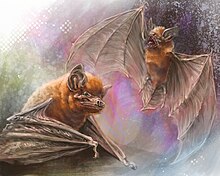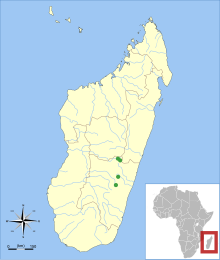Manavi long-fingered bat
| Manavi long-fingered bat | |
|---|---|

| |
| Scientific classification | |
| Domain: | Eukaryota |
| Kingdom: | Animalia |
| Phylum: | Chordata |
| Class: | Mammalia |
| Order: | Chiroptera |
| Family: | Miniopteridae |
| Genus: | Miniopterus |
| Species: | M. manavi
|
| Binomial name | |
| Miniopterus manavi Thomas, 1906
| |

| |
| Collection localities of Miniopterus manavi | |
The Manavi long-fingered bat (Miniopterus manavi)
Miniopterus manavi is a small, blackish or reddish-brown Miniopterus; its forearm length is 37.6 to 39.2 mm (1.48 to 1.54 in). The tragus (a projection in the outer ear) is narrow and ends in an angular tip. The uropatagium (tail membrane) is well-furred and the palate is flat.
Taxonomy
Miniopterus, a widespread genus of bats in Africa, southern Eurasia, and Australia, was first recorded from Madagascar by
In the 2000s,
During 2009,
Description
Miniopterus manavi is a diminutive species[18] with fur of medium length.[4] The upperparts are blackish or reddish brown.[19] Other small Malagasy Miniopterus are lighter.[20] The ears mostly lack hair and end in a rounded tip. The tragus (a projection on the inner side of the outer ear) is thin for most of its length, ends in an angular tip, and has a flange at the medial side (towards the midline of the animal).[21] The tragus is differently shaped in other species.[18] The wings and uropatagium (tail membrane) are blackish and are attached to the upper leg at the same level, above the ankle.[21] The uropatagium is densely haired above and more sparsely below, as in M. mahafaliensis and M. brachytragos; M. griveaudi and M. aelleni have more nearly naked uropatagia.[22]
In the single specimen of true M. manavi that Goodman and colleagues could measure, total length is 90 mm (3.5 in), tail length is 39 mm (1.5 in), hindfoot length is 6 mm (0.24 in), tragus length is 6 mm (0.24 in), ear length is 10 mm (0.39 in), and body mass is 6.4 g (0.23 oz). The length of the forearm is known from four specimens; it ranges from 37.6 to 39.2 mm (1.48 to 1.54 in), averaging 38.5 mm (1.52 in).[23]
In the skull, the rostrum (front part) is rounded.[21] The central groove in the nasal depression is relatively narrow.[24] The frontal bones are inflated and bear a prominent sagittal crest.[21] Further back on the braincase, the lambdoid crest is poorly developed.[24] The middle part of the palate is flat, not concave as in M. brachytragos, M. griveaudi, and M. mahafaliensis.[22] At the palate's back margin is a short, thick posterior palatal spine.[24]
Distribution and ecology
The currently known distribution of M. manavi extends around the eastern margin of the Central Highlands, from the vicinity of Ambositra in the north to Vinanitelo in the south, at 900 to 1,500 m (3,000 to 4,900 ft) above sea level.[25] The 2008 IUCN Red List assesses the species as "Least Concern", citing its wide distribution, though it is sometimes hunted for food. However, the account predates the recognition of M. aelleni, M. brachytragos, M. griveaudi, and M. mahafaliensis as separate species.[1] Although some ecological data about M. manavi have been published, these need to be reevaluated with the recognition of numerous additional species within M. manavi.[26] Species of Miniopterus generally feed on insects, breed seasonally, and roost in large colonies in caves.[27] The myobiid mite Calcarmyobia comoresensis has been recorded on M. manavi.[28]
References
- ^ . Retrieved 16 November 2021.
- ^ Dobson, 1878, pp. 350, 352; Hill, 1993, p. 401; Simmons, 2005, p. 521
- ^ Thomas, 1906, pp. 175–176
- ^ a b Thomas, 1906, p. 176
- ^ Hill, 1993, p. 401
- ^ Simmons, 2005, p. 520
- ^ Goodman et al., 2009b, p. 28
- ^ Juste et al., 2007, pp. 30, 34
- ^ Weyeneth et al., 2008, fig. 2, p. 5215
- ^ Weyeneth et al., 2008, p. 5207
- ^ Weyeneth et al., 2008, p. 5205, figs. 2–3
- ^ Goodman et al., 2009a; 2009b, pp. 1–2
- ^ Goodman et al., 2009a, p. 346
- ^ Goodman et al., 2009b, pp. 5–6
- ^ Goodman et al., 2009b, p. 1
- ^ Goodman et al., 2009a, table 2; 2009b, p. 5, fig. 2
- ^ Goodman et al., 2009a, pp. 346–347
- ^ a b Goodman et al., 2009b, p. 21
- ^ Thomas, 1906, p. 176; Goodman et al., 2009a, p. 349
- ^ Goodman et al., 2009b, pp. 21–22
- ^ a b c d Goodman et al., 2009a, p. 349
- ^ a b Goodman et al., 2009b, p. 22
- ^ Goodman et al., 2009b, table 3
- ^ a b c Goodman et al., 2009a, p. 350
- ^ Goodman et al., 2009a, p. 351; 2009b, p. 5
- ^ Goodman et al., 2009b, p. 31
- ^ Nowak, 1994, p. 222
- ^ Uchikawa, 1985, p. 45
Literature cited
- Andriafidison, D., Cardiff, S.G., Goodman, S.M., Hutson, A.M., Jenkins, R.K.B., Kofoky, A.F., Racey, P.A., Ranivo, J., Ratrimomanarivo, F.H. and Razafimanahaka, H.J. 2008. Miniopterus manavi. In IUCN. IUCN Red List of Threatened Species. Version 2009.2. <www.iucnredlist.org>. Downloaded on July 13, 2010.
- Dobson, G.E. 1878. Catalogue of the Chiroptera in the collections of the British Museum. London: British Museum,
- Goodman, S.M., Maminirina, C.P., Weyeneth, N., Bradman, H.M., Christidis, L., Ruedi, M. and Appleton, B. 2009a. The use of molecular and morphological characters to resolve the taxonomic identity of cryptic species: the case of Miniopterus manavi (Chiroptera: Miniopteridae) (subscription required). Zoologica Scripta 38:339–363.
- Goodman, S.M., Maminirina, C.P., Bradman, H.M., Christidis, L. and Appleton, B. 2009b. The use of molecular phylogenetic and morphological tools to identify cryptic and paraphyletic species: Examples from the diminutive long-fingered bats (Chiroptera: Miniopteridae: Miniopterus) on Madagascar. American Museum Novitates 3669:1–34.
- Hill, J.E. 1993. Long-fingered bats of the genus Miniopterus (Chiroptera: Vespertilionidae) from Madagascar. Mammalia 57(3):401–405.
- Juste, J., Ferrández, A., Fa, J.E., Masefield, W. and Ibáñez, C. 2007. Taxonomy of little bentwinged bats (Miniopterus, Miniopteridae) from the African islands of São Tomé, Grand Comoro and Madagascar, based on mtDNA. Acta Chiropterologica 9:27–37.
- Nowak, R.M. 1994. Walker's Bats of the Old World. Baltimore: The Johns Hopkins University Press, 287 pp. ISBN 978-0-8018-4986-2
- Thomas, O. 1906. New African mammals of the genera Cercopithecus, Scotophilus, Miniopterus, Crocidura, Georychus, and Heliophobius. Annals and Magazine of Natural History (7)17:173–179.
- Uchikawa, K. 1985. Calcarmyobia from the Ethiopian region (Acarina, Myobiidae). Bulletin of the British Museum (Natural History), Zoology Series 48(1):45–55.
- Weyeneth, N., Goodman, S.M., Stanley, W.T. and Ruedi, M. 2008. The biogeography of Miniopterus bats (Chiroptera: Miniopteridae) from the Comoro Archipelago inferred from mitochondrial DNA (subscription required). Molecular Ecology 17:5205–5219.

